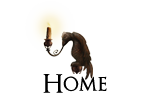Scribble City Central's third #FantabFri A -Z is brought to you by Inbali Iserles, author of The Tygrine Cat and its thrilling sequel, The Tygrine Cat on the Run.
Generally, I'm more of a dog than a cat person, but Inbali's brilliant evocation of the feline world around Cressida Lock won me over immediately. She somehow gets deep into the cat mindset, so that as a reader I could feel what it was like to sense, smell and live as a cat. Mati - last catling of the Tygrine clan - is both an endearing and inspiring character, and I was delighted when the second of his adventures came out. This is a slightly darker, more thoughtful, more mystical book than the first, where Mati walks the paths of the feline spirit world, as well as those of the real one, trying to find a path to safety for himself and his kin. I very much liked the way Inbali weaves Mati's physical journey in with his spiritual one - it gives a real added depth and dimension to the book - and the wicked Suzerain of the Sa tribe is right up there with the best of the villains. The cat myths she writes about are well-crafted and convincing, so it is no surprise that she chose B for Bastet - cat goddess extraordinaire - to write about for SCC. So, here is Inbali to tell you something about the journey that led her to Bastet - and about the cat goddess herself.
B for Bastet
Feline Goddess Extraordinaire
Inbali: When I was eleven my family upped sticks and moved from East Anglia to Tucson, Arizona. I hadn’t grown up surrounded by wildlife – in Cambridge, you were lucky to spot a robin or the occasional squirrel. Tucson was different, a city in the dunes, where sun-soaked adventures revealed poisonous lizards, scarlet birds and snakes hunkered down behind rocks. It was in this arid climate that I read about another desert far away, and long ago, and the burnished city of Bubastis in the Nile Delta where cats were worshipped as gods.
Or one cat at least.
Her name was Bastet, the beautiful daughter of the sun god, Ra. While earlier representations saw her glaring at humans through the implacable eyes of a lioness, the more peaceable cat-goddess held no threat to her devotees. A natural mother with great tenderness towards her kittens, she seemed the epitome of maternal love. Statues portrayed her with a regal, wedge-shaped face, large patient eyes and pointed ears. Jewels adorned her alongside symbols of protection such as the tearful Eye of Horus and the resilient dung beetle. Sometimes depicted with the body of a woman, Bastet’s hand clasped an ankh as her feline face looked on benevolently. Love me and I will shield you, she seemed to say: hurt my friends and I will strike you down with sharp, extended claws.
Who could fail to be charmed by her enchanting gaze?
Was this the original cat, I wondered, the one from whom all modern moggies descended? Instructed to pursue individual history projects – a joy all too rare amid curriculum-obsessed agendas – I wrote about Bastet. Others focused on projects as diverse as Gettysburgh, JFK and 1960s fashion. I lost myself in the world of the Nile peoples, thrilled in the knowledge that in Ancient Egypt it was a crime to kill a cat – a crime punishable by death. I pondered my tortoishell-and-white, back home in Cambridge under the charge of a family friend. What relationship did that garrulous pirruper have with the cats of the ancient world? True, my moggy was stout and idle, but I had seen what became of the neighbour’s dog when he’d strayed into our garden: in the twitch of a tail, in a hiss and a pounce, her rebellious spirit endured.
Years later I returned to Bastet and the Nile Delta. Imbued with an identity, with her own back-story of unutterable tragedy, this mother-goddess came to represent the first cat in The Tygrine Cat and The Tygrine Cat: On the Run. I named her Te Bubas to allude to the Bastet cult in the city of Bubastis, but to indicate that in this, as in everything else, humans had grasped only half the story. Here was where Egyptian legend ended and the feline myth began (for Bastet is the goddess as humans understand her, and the Tygrine Cat stories explore the way in which cats might see themselves).
"The Creators drew light from the universe, as pure and hard as any diamond. They crushed it underfoot and scattered it onto a young earth as tiny grains of sand, forging a desert without beginning or end.”
So Te Bubas explains the birth of world to a shy young catling who has strayed into the feline spirit realm.The catling listens, bewildered. He does not understand how he fits in to the land that she describes. He knows nothing about the proud and ancient felines who stalked the deserts of the world long before he was born. Yet Mati is the last prince in line to the Tygrine throne, a cat with extraordinary powers and more enemies than he can imagine, and his adventures are only just beginning.
SCC: Thank you, Inbali. Indeed, who could fail to be charmed by the lovely B for Bastet? Definitely a shining star of the feline pantheon.
Next week: B for Big Bad Wolf (scary monster of every child's nightmares) with Tony Bradman, author of Dilly the Dinosaur, journalist and reviewer




















3 comments:
No wonder the potential penalty for killing a cat in Ancient Egypt was death! Cats are such obviously superior beings! Just purr-fect in fact! :-)
Thankyou Inbali (and you too Lucy).
Cat lovers of the world, unite, eh, Cat? Mind you, there'll be plenty for the dog fans later on in the series....
How evocative, Inbali. But my bit of Cambridge has deer, snakes, a pheasant that roosts in our tree, foxes that eat our chickens and newts that visit our pond, so it's not entirely a wildlife-desert!
Post a Comment